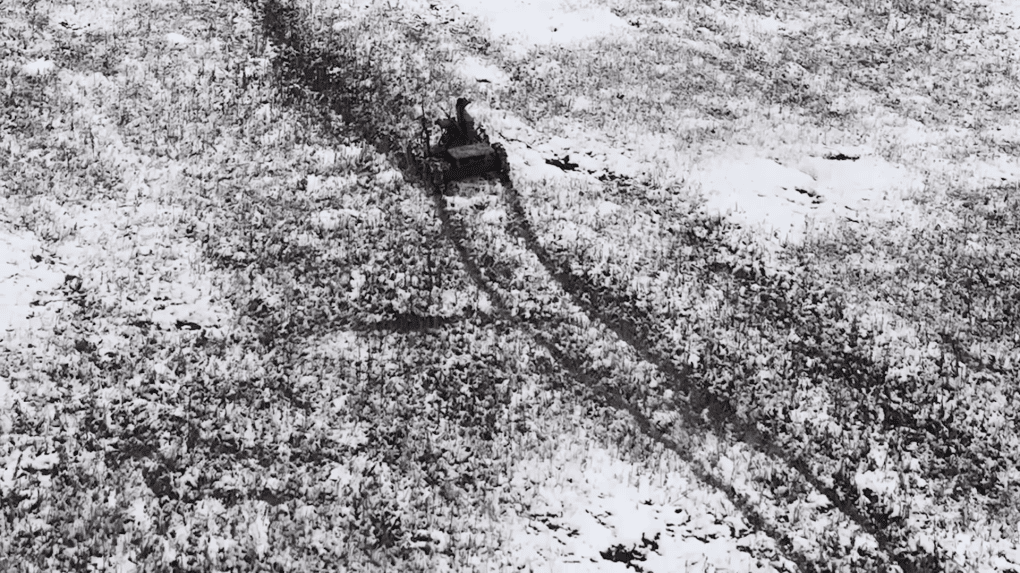- Category
- War in Ukraine
Ukraine Conducts the First-Ever Assault Done Exclusively with Drones
At the close of 2024, the Ukrainian 13th National Guard Brigade "Khartiia" surprised the Russian forces by executing the first-ever combined-arms maneuver conducted solely with drones. This historic attack involved a wide range of systems, from ground drones fitted with machine-gun mounts to FPVs.
“They [Russians] were in a panic,” said a 32-year-old S3 Officer at the Khartiia brigade headquarters, callsign “Shuhai,” who oversaw the now-famous assault. He shared details of intercepted communications, adding, “The enemy soldiers on the ground were especially taken by surprise.”
UNITED24 Media spoke with those directly involved in planning and executing the mission, offering an in-depth look at modern combat drone capabilities and the success of this unprecedented assault.
The drones take the lead

The assault's goals were to set the stage for further advancement, force Russians to regroup, eliminate key targets, and test the command center's coordination with the drone crews.
“UAVs are like common sense in our time, along with ground platforms that enter enemy positions and explode or platforms that move in and shoot at them,” said Shuhai. “This approach is not common, so we catch the enemy off guard.”
The mission pushed the limits of modern warfare, pulling off a combined-arms maneuver using only robotic systems, ranging from small UAVs to larger units weighing up to 1,000 pounds.
But launching this unprecedented assault required meticulous preparation, as there wasn't much precedent for such an offensive. Shuhai explains that every detail was carefully mapped out to ensure the drones would be deployed precisely.
Routes and actions for all robotic platforms were planned and simulated using physical mock-ups and virtual models, resulting in near-perfect execution when it mattered most.
Khartiia Brigade has not disclosed the exact number of drones used in the attack. However, several dozen drones of various types, ranging from small UAVs to larger models weighing up to 1,000 pounds, were involved.
The drones included:
Ground and aerial FPV drones
Ground drone equipped with a machine gun turret
Heavy bomber quadrocopter drones
Aerial drones for reconnaissance and surveillance
A 26-year-old chief sergeant of the UGV platoon and a former molecular biologist, callsign “Pan,” reflected on the operation's success and the rising significance of domestically produced drones.
"Every robot we use is made in Ukraine," he said. "It was a new era of combined robotic warfare, with each system contributing to making the occupiers' day a whole lot worse. That feels pretty great."
Lessons learned

While the operation was largely successful, it wasn’t without its setbacks. The brigade did experience some equipment losses, but not due to the Russian soldiers. The video clearly shows that the ground drones launching the assault were heavily targeted by mortar strikes, bomb-dropping drones, and Russian FPV drones in an attempt to disrupt the operation.
However, the Ukrainian drones managed to avoid destruction. The main issue came from the terrain itself—some ground drones got stuck in difficult conditions, creating a minor setback. Despite this, none of the systems were destroyed.
"One of our kamikaze ground drones got stuck in the dirt on its way to the target. Our turret also got stuck on its way back home," Pan explained. "However, none of them were destroyed by the Russians."
The operation proved successful, forcing the Russian forces to regroup and react, catching them off guard while successfully destroying key shelters and obstacles. But it also highlighted areas for improvement.
One key lesson was the need for better coordination between ground platforms and UAVs, along with more effective management of drone communications. Despite these challenges, the operation's success demonstrated the potential of robotic systems in modern warfare. The loss of equipment is always a risk, but when it comes to drones, it is far less tragic than the loss of human life. "When one is destroyed, we can immediately deploy another," Pan added. "If a human is lost, it is an irreparable tragedy."
The state of global drone warfare

Global companies like Estonia's Milrem Robotics, the American-Israeli firm Roboteam, and the UK’s Unmanned System Technologies are making significant strides in developing ground robots for military use.
However, despite the progress, no one has yet created a product that can ultimately replace human soldiers. Each system still faces challenges with reliability, coordination, and adaptability in real combat scenarios.
In this regard, the Khartiia Brigade holds a unique position, with arguably the most experience in actual battlefield conditions. As one of the few units to carry out a robot-led assault, their insights into the practical use of these systems in high-pressure situations are invaluable, offering lessons that both companies and military forces are eager to learn from.
Many in the field compare this time to the era of muskets in armed warfare. As Pan puts it, "These are only the first steps we are taking. What the Russians are doing in the field of ground vehicles also represents early steps."
As drone warfare evolves, fully autonomous robots without human operators could eventually become a reality. But for now, the focus is on refining current systems, improving coordination, and overcoming challenges like terrain and communication.
Looking ahead, Shuhai believes the Russians can expect more drone-exclusive operations. "The Russians should definitely prepare for more operations like this," he said. "However, they will still be a surprise for them."
As this operation illustrates, it’s becoming increasingly clear that a future where machines dominate the battlefield is closer than ever. For now, these instances remain limited, as they require careful planning, precise execution, and accessible technology.
However, with these elements in place—albeit in a limited capacity—it’s possible to carry out successful military operations with minimal human involvement—a revolutionary leap forward in modern combat.


-f88628fa403b11af0b72ec7b062ce954.jpeg)
-b63fc610dd4af1b737643522d6baf184.jpg)


-29a1a43aba23f9bb779a1ac8b98d2121.jpeg)

-24deccd511006ba79cfc4d798c6c2ef5.jpeg)